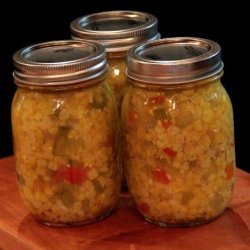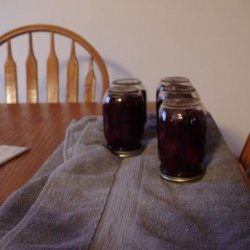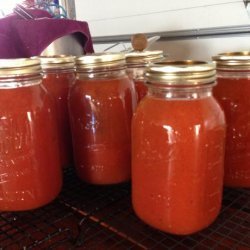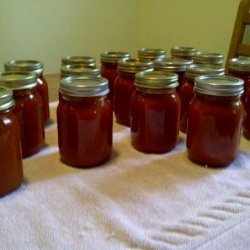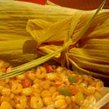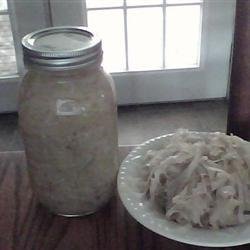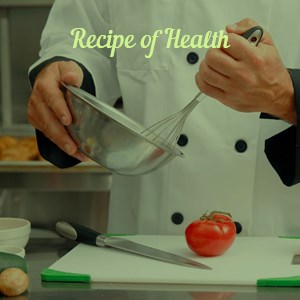Directions:
- Put water in boiling-water canner: It should be 2/3 full if using pint-size jars, 1/2 full for quart jars. Set rack on pan rim, cover pan, and bring water to a boil over high heat (for pickles, bring water to 180°-185°).
- Meanwhile, for all recipes except jams, wash canning jars, bands, and lids in hot, soapy water, or run jars and bands through a dishwasher and hand-wash lids; drain. If making jam, which has a short processing time, sterilize jars: When water in canner is boiling, place jars on rack, lower into water, and boil for 10 minutes (at elevations of 1,000 feet or higher, add 1 minute for each 1,000-foot increase above sea level). Reduce heat to a simmer and keep jars in water until needed.
- Follow manufacturer's directions for preparing lids and bands.
- Rinse all fruit and vegetables well.
- For pourable foods, such as jam or chutney, quickly ladle hot mixture through a wide funnel into jars, leaving headspace (the distance between top of jar rim and food inside) as recommended. For mixtures involving large pieces such as whole tomatoes, arrange pieces in jars with a spoon, then pour hot liquid through funnel over foods, again leaving headspace as recommended in recipe. (If the last jar isn't completely full, let cool, then serve or chill; do not process.) To release any air bubbles in chunky mixtures, run a clean plastic knife around the inside of the jars (metal knives can damage jars). Wipe jar rims and outer threads with a clean, damp cloth.
- Center lids on jars so the red or gray sealing compound is touching jar rims. Using a hot pad, screw bands on firmly, but don't force.
- Place jars on rack in canner and lower into water. The water should cover jars by at least 1 inch; if necessary, add more hot water.
- Cover canner, return water to a boil (or to 180°-185° for pickles), and process for time specified in recipe; if boiling water starts spilling from canner, reduce heat slightly.
- Using tongs and a hot pad, lift rack with jars onto edge of canner. With jar lifter, remove jars and set upright on towels on a counter. Do not tighten bands. Let jars cool completely at room temperature.
- Press on the center of each lid-if it stays down, jar is sealed; if it pops up, chill the jar and serve within 2 to 3 weeks (see below). Remove bands. Wipe jars and lids with a clean, damp cloth. If desired, replace bands.
- Label jars; store in a cool, dark place for up to 2 years for best quality. Once opened, chill; consume jams, chutneys, and relishes within 3 weeks, pickles within 2 months.
- Sunset's Canning Tips:
- When making jams and jellies, you can add 1/2 tsp. butter to prevent foam from forming during cooking (see recipes for more details). If you omit the butter, skim off the foam before ladling jam or jelly into jars. The recipe will yield about 1/4 cup less.
- Another tip for jams and jellies: Measure all the sugar into a bowl before beginning the recipe. Many canning recipes call for a large volume of sugar to be added when a mixture is already boiling; measuring ahead simplifies this step and prevents mistakes.
- Use a ruler to measure volume. Some recipes call for a mixture to be reduced by a certain amount. To ascertain this easily, insert a clean, wood ruler into the pan before cooking and measure how far up the mixture comes. Then cook as directed until it has reduced by the percentage specified. For example, if uncooked mixture measures 4 inches in pan and recipe says to reduce by half, cook it down to 2 inches.
- Canning Safely:
- Home canning is not complicated, but for success and safety, you must precisely follow the recipes and procedures described here.
- Do not double the recipes. If you want to make more, cook successive batches.
- Always use the processing method recommended in the recipe. All of our mixtures are sufficiently high in acid to be safe when processed in a boiling-water canner (at 212°). However, meats, seafood, and low-acid vegetables must be processed in a pressure canner (at 240°).
- Maintain safe levels of vinegar and sugar. Use the recommended amount of commercial vinegar to prevent the growth of harmful bacteria. Using the full amount of sugar called for in jams and chutneys is also vital for safe preservation; plus, it ensures the correct consistency.
- For more details on canning safety, visit the National Center for Home Food Preservation (www.uga.edu/nchfp) for an excellent reference on the principles and techniques of canning.
- Thanks to Elizabeth Andress, food-safety specialist for the USDA at the University of Georgia Extension Service for sharing technical expertise.
Nutrition Facts
| Amount Per 1 Serving | |||
| Calories | 0 Kcal (0 kJ) | ||
| Calories from fat | 0 Kcal | ||
| % Daily Value* | |||
| Total Fat | 0g | 0% | |
|---|---|---|---|
| Amount Per 100 g | |||
| Calories | 0 Kcal (0 kJ) | ||
| Calories from fat | 0 Kcal | ||
| % Daily Value* | |||
| Total Fat | 0g | 0% | |
|---|---|---|---|
* Percent Daily Values are based on a 2000 calorie diet. Your daily values may be higher or lower depending on your calorie needs.
Find out how many calories should you eat.
Get Your Recipe of Health!
Follow RecipeOfHealth on Facebook!


